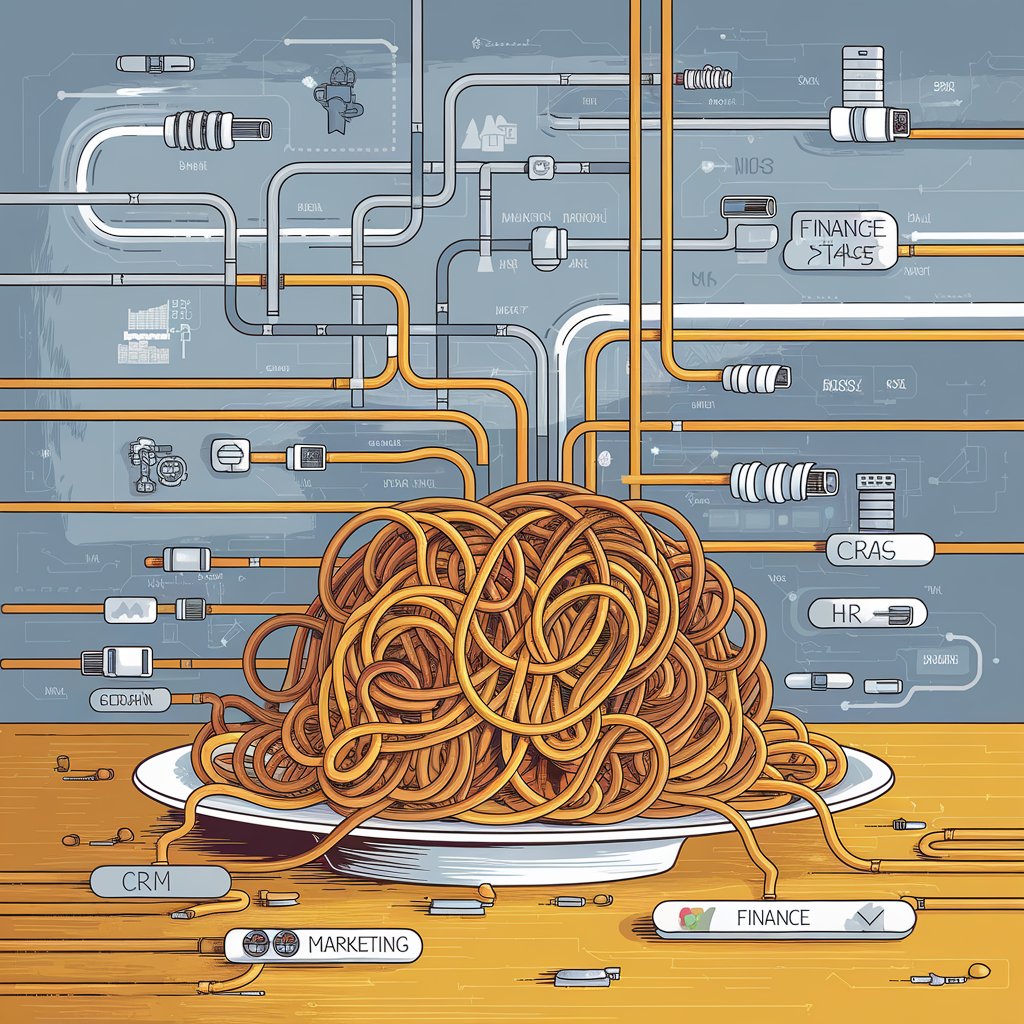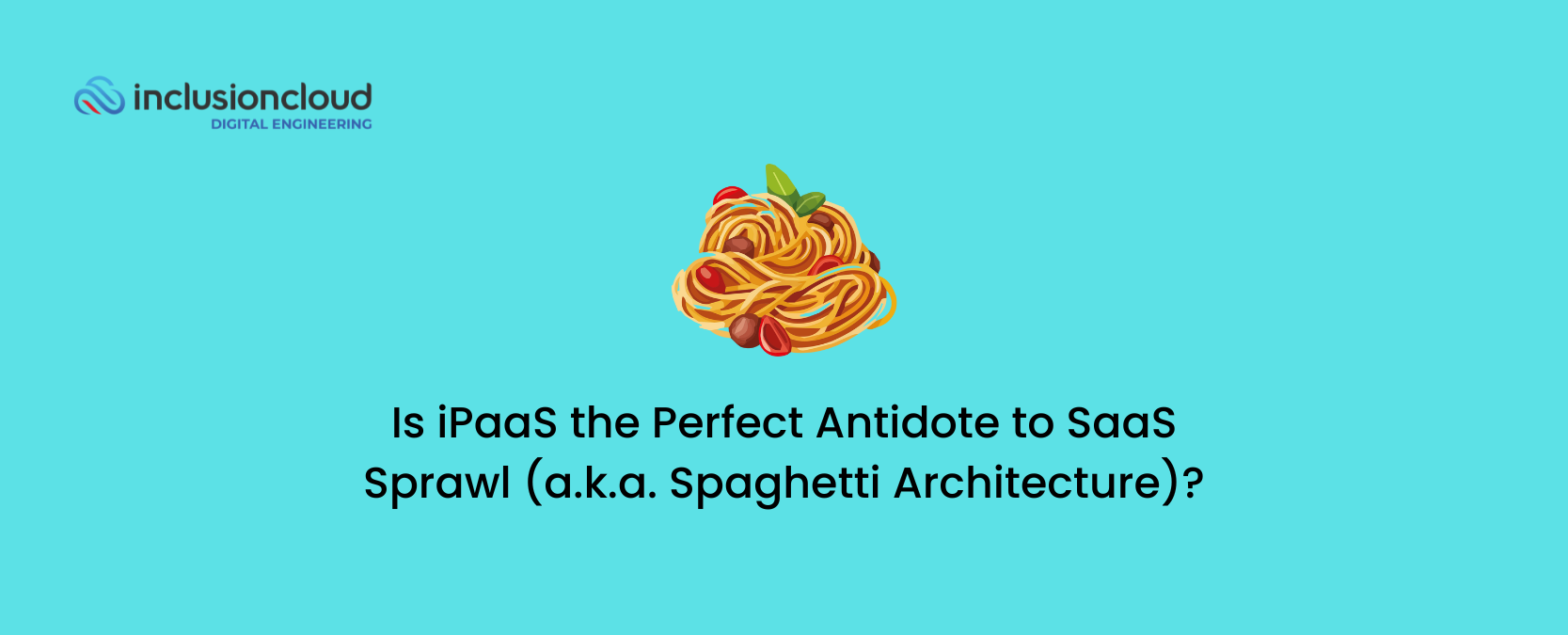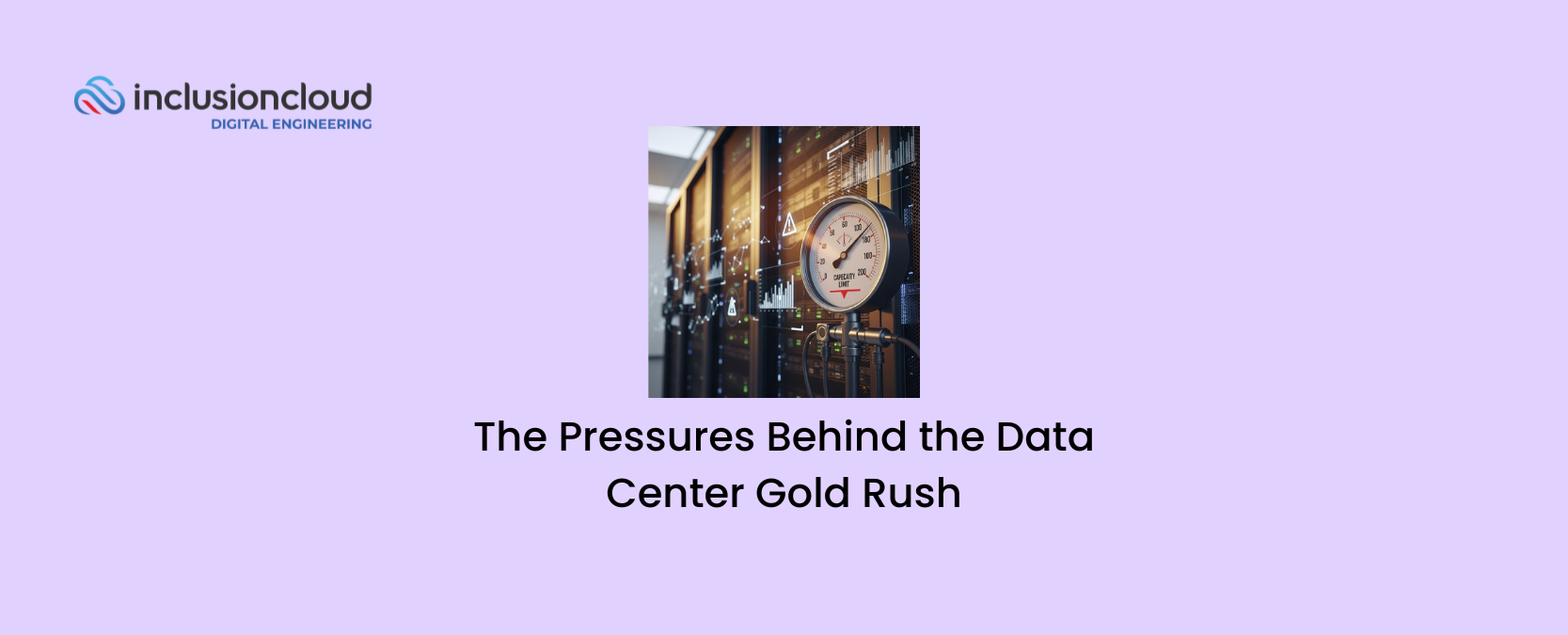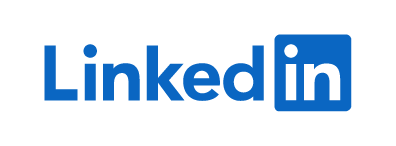One of the biggest headaches for CIOs these days is something called SaaS sprawl—often referred to as “spaghetti architecture.” It’s been steadily driving up IT budgets over the past year. Let’s look at a simple example to see how this problem shows up in a typical company:
The marketing team wants to up their game on social media. They’re thinking, “We need to schedule posts more efficiently—let’s get a SaaS tool for that.” So, they sign up for a popular social media management platform. A few months later, the sales team realizes they could use a better way to track customer interactions. They’re like, “We need to manage customer relationships better—let’s get a CRM.” And before you know it, they’ve got a SaaS-based CRM system. Then, HR decides they need a smoother way to handle performance reviews and thinks, “We need better evaluations—let’s get an HR app.”
While each of these SaaS tools solves a specific problem for their department, this piecemeal approach leads to what we call SaaS sprawl. Sound familiar? It happens when companies end up with a bunch of disconnected apps that don’t communicate with each other. This can lead to several serious challenges, such as:
- Data Silos
- Rising IT Costs
- Security Vulnerabilities
- Inefficient Workflows
So, what’s the fix? iPaaS (Integration Platform as a Service) is a potential antidote to SaaS sprawl. How? It connects all those scattered applications, making data, apps, and workflows accessible and integrated. By bringing everything under one roof, iPaaS can directly address the key hurdles posed by spaghetti architecture, especially when it comes to skyrocketing IT costs.
But before we explore how iPaaS can untangle this mess, let’s start with the basics and break down a few key concepts.
What Is SaaS?
Software as a Service (SaaS) refers to cloud-based software applications that are accessed over the internet. Instead of installing software on individual machines, users access SaaS tools through a web browser, making them more flexible and scalable. Common SaaS tools include customer relationship management (CRM) systems like Salesforce, collaboration platforms like Slack, and project management tools like Asana.
For CIOs, this growing SaaS sprawl is a red flag because it complicates IT management and data governance.
What Is SaaS Sprawl, and Why Is It a Problem?
SaaS sprawl happens when an organization adopts too many SaaS applications without centralized oversight or management. Different departments may start using their own SaaS tools independently, leading to a fragmented software ecosystem. According to MuleSoft, the average company uses around 1000 applications, and this number is growing rapidly.
Without a proper strategy to manage all these tools, businesses face:
- Increased Costs: Uncontrolled adoption of SaaS tools can lead to redundant apps and inflated subscription costs.
- Data Silos: With each department using different SaaS apps, data becomes isolated, making it difficult to access and analyze.
- Security Risks: When apps are adopted without IT oversight, there’s a higher risk of security vulnerabilities, such as unauthorized data access or compliance issues.
- Operational Inefficiencies: The lack of integration between systems leads to inefficient workflows and manual data entry, slowing down business processes.

When we say this issue is growing so quickly, it’s partly due to the broader adoption of GenAI apps in workplaces, which has skyrocketed from 22% in 2023 to 75% in 2024, according to a survey. This acceleration is driven by:
- Every industry now has niche GenAI tools to automate tasks.
- These tools are often adopted at the department level.
- The accessibility of GenAI platforms encourages employees to experiment with new AI tools without IT’s knowledge (called “shadow IT”).
- The need for speed on adoption can lead to unplanned integrations.
What’s driving the challenges for CIOs and IT budgets?
But what are some of the factors causing such trouble for CIOs and IT budgets?
- Companies adopt multiple tools to cover various functions.
- SaaS applications are easy for employees to use and quick to deploy.
- Departments, and even individual teams, are making decentralized software purchases.
- Hybrid work is leading companies to adopt more apps to support collaboration, communication, and workflow management.
- The boom of generative AI (GenAI) apps.
We can mostly attribute the acceleration of SaaS sprawl to the widespread presence of GenAI. This is an often-overlooked problem, and without careful planning, GenAI can lead to an even more tangled ‘spaghetti’ web of tools, making it harder to unlock the true potential of AI across the organization. But don’t worry, we’re here to help you untangle the chaos with our enterprise integration solutions.
What Is iPaaS, and How Does It Work?
Once we’ve traced our way back to understanding the more general concepts, it’s time to get to the point of the article and explain why we say that iPaaS is one of the solutions to combat SaaS sprawl.
iPaaS (Integration Platform as a Service) is a cloud-based solution that helps businesses connect different software applications, data, and services, regardless of whether they’re on-premise or in the cloud. Think of iPaaS as a central hub where all your apps can talk to each other. Instead of creating custom, complicated connections between every app, iPaaS provides pre-built connectors and tools to make integration faster, easier, and more scalable.
For example, if your sales team uses Salesforce, your marketing team uses HubSpot, and your accounting department uses QuickBooks, iPaaS can link these systems together. This way, when customer data is updated in Salesforce, it can automatically sync with HubSpot and QuickBooks without manual input. This makes your workflows more efficient and ensures that your data stays consistent across different platforms.
So, how can iPaaS help mitigate SaaS sprawl? Here are some key ways:
How Does iPaaS Combat SaaS Sprawl?
Now, let’s take a look at the challenges CIOs are facing with app overload and how iPaaS solutions offer a concrete solution to each of these issues:
Challenge 1: Lack of Visibility and Control
CIO might say:
- “We have so many apps running, I don’t even know what half of them do anymore.”
- “Our tech stack is all over the place. I need a clear view of what’s being used and where.”
iPaaS Solution: iPaaS provides a centralized dashboard where all connected applications are visible. This allows CIOs to monitor app usage, track performance, and gain insights into how tools are being used across the organization. With iPaaS, you can identify redundant or underused apps and make more informed decisions on which tools to keep or eliminate.
Challenge 2: Data Silos
CIO might say:
- “Our data is scattered across so many platforms that it’s hard to get a clear picture of what’s happening.”
- “Each department has its own set of tools, but there’s no easy way to share information between them.”
iPaaS Solution: iPaaS integrates disparate systems, breaking down data silos by ensuring seamless data flow between applications. This way, information entered in one app is automatically updated across all connected platforms, enabling a unified view of business operations. It eliminates manual data entry and improves data consistency.
Challenge 3: High Costs Due to Redundant Apps
CIO might say:
- “We’re spending a fortune on app subscriptions, but I’m sure we don’t need all of them.”
- “I see duplicate tools across different teams, and it’s driving up our costs.”
iPaaS Solution: With iPaaS, businesses can identify duplicate tools and streamline their software ecosystem. By providing insights into app usage, iPaaS helps companies optimize their SaaS subscriptions, cutting unnecessary costs and focusing only on the essential tools. This reduces software expenses and boosts ROI.
Challenge 4: Security and Compliance Risks
CIO might say:
- “Every new app introduces potential security risks, and it’s hard to monitor them all.”
- “How can I ensure compliance when everyone is using different tools?”
iPaaS Solution: iPaaS platforms enforce consistent security protocols across all integrated apps, ensuring data encryption, authentication, and compliance with industry standards like GDPR and HIPAA. This helps businesses maintain a high level of data security and avoid the risks associated with shadow IT.
Challenge 5: Inefficient Workflows
CIO might say:
- “Our employees spend too much time switching between apps to get simple tasks done.”
- “We need to automate more of our processes, but our apps don’t talk to each other.”
iPaaS Solution: iPaaS automates workflows by connecting different applications, so actions in one app can trigger automatic responses in another. This reduces the need for manual input and ensures that processes run smoothly and efficiently. For instance, iPaaS can automate tasks like data syncing, notifications, and reporting, saving time and reducing errors.
Challenge 6: Scalability and Adaptability
CIO might say:
- “Our current integration setup isn’t built to scale, and we’re adding more apps as we grow.”
- “We need an integration solution that can adapt as our business evolves.”
iPaaS Solution: iPaaS platforms are designed to be scalable and flexible, making it easy to add new apps and integrate them without disrupting existing systems. As businesses grow and their tech needs change, iPaaS ensures that the integration infrastructure can scale seamlessly to accommodate new software, workflows, and data sources.
Who Are the Leading iPaaS Vendors in 2024?
According to Gartner’s Magic Quadrant for Enterprise Integration, the following iPaaS vendors are considered leaders:
- MuleSoft
- Dell Boomi
- Informatica
- Workato
- Microsoft Azure Logic Apps
Why Do You Need a Partner Like Inclusion Cloud for iPaaS?
Sure, iPaaS makes integrations easier, but getting it right isn’t always simple. That’s where Inclusion Cloud comes in. With over 17 years of integration expertise, we help businesses deploy and optimize iPaaS platforms that fit their exact needs.
Here’s why you need a partner for your iPaaS implementation:
- Customization: Every company’s tech setup is different. Maybe you’re trying to link a custom-built CRM to a legacy ERP, or you need your e-commerce site to talk to your logistics software. Pre-built connectors might not cut it. We craft tailored solutions that make everything click together.
- Ongoing Support: Setting up iPaaS is just step one. What happens when you add a new tool or your workflows change? Integrations can break, data might not sync, and it becomes a headache. Inclusion Cloud offers continuous monitoring.
- Keeping Your Data Safe: Every integration involves data exchange, and not managing that carefully opens doors to risks.
- Maximizing ROI: Let’s be real: iPaaS isn’t just about connecting apps; it’s about making sure those connections save time, cut costs, and drive results. We make sure you’re paying only for what you need.
Need help to untangle your software setup? Book a call with us, and we’ll set up a system that’s clear, efficient, and secure.
Plus, don’t miss out on more tips and insights—follow us on LinkedIn for updates on how to simplify your tech stack.





